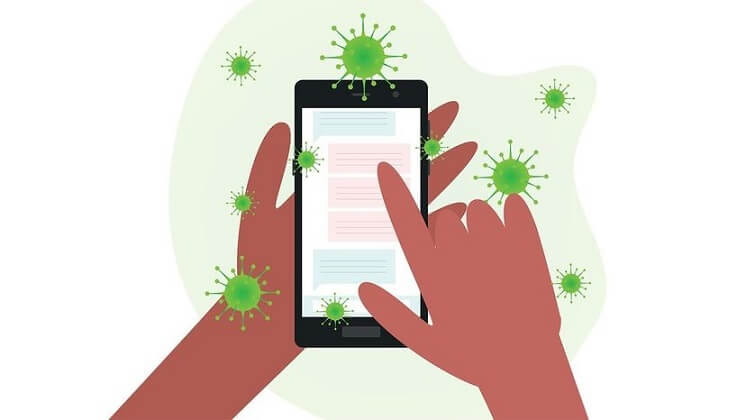
Your Phone Is A Germ Factory, So Stop Taking It To The Toilet
Three out of four Americans take their phones to the bathroom, which actually has fewer germs than their phones.
By: Primrose Freestone | The Conversation
We carry them everywhere, take them to bed and to the bathroom. And for many people, their smartphone is the first thing they see in the morning. More than 90% of the world’s population owns or uses a smartphone and many couldn’t manage without one.
But most health concerns about phones usually focus on the distraction they can cause while driving, the possible effects of radio frequency exposure or just how addictive they can be. The risk of microbial infection from your phone is much less of a concern — but it’s very real.
ContentsStop Doomscrolling On The John
A 2019 survey found that most people (57%) in the U.K. use their phones on the toilet. A separate study found three in four Americans (74.5%) use their phones while on the toilet. So it’s not surprising studies have found our mobile phones are dirtier than toilet seats.
We give our phones to children to play with (who aren’t exactly well known for their hygiene). We also eat while using our phones and put them down on all sorts of (dirty) surfaces. All of which can transfer microbes onto our phones, as well as food deposits for those microbes to eat.
It’s been estimated that people touch their phone hundreds, if not thousands, of times a day. And while many of us wash our hands regularly after say, going to the bathroom, cooking, cleaning or gardening, we are much less likely to consider washing our hands after touching our phones.
But given how disgusting and germ-infested phones can be, maybe it’s time to think more about mobile phone hygiene.

Your Phone’s a Magnet For Germs, Bacteria & Viruses
Hands pick up bacteria and viruses all the time and are recognized as a route for acquiring infection. So too are the phones we touch. A number of studies conducted on the microbiological colonization of mobile phones show that they can be contaminated with many different kinds of potentially pathogenic bacteria.
These include:
- E. coli: comes from human poo and causes diarrhoea
- Staphylococcus: causes skin infections
- Actinobacteria: can cause tuberculosis and diphtheria
- Citrobacter: can lead to painful urinary tract infections
- Enterococcus: known to cause meningitis
Klebsiella, Micrococcus, Proteus, Pseudomonas and Streptococcus have also been found on phones and all can have equally nasty effects on humans.
Research shows that many pathogens on phones are often antibiotic-resistant, meaning they can’t be treated with conventional drugs. This is worrying as these bacteria can cause skin, gut and respiratory infections that can be life-threatening.
Research also has found that even if you clean your phone with antibacterial wipes or alcohol, it can still be recolonized by microorganisms, indicating that sanitization must be a regular process.
Phones contain plastic that can harbour and transmit viruses, some of which — like the common cold virus — can live on hard plastic surfaces for up to a week. Other viruses, such as rotavirus (a highly infectious stomach bug that typically affects babies and young children), influenza and norovirus, can persist in an infectable form for several days.
Indeed, the U.S. Centres for Disease Control and Prevention has guidelines for cleaning and disinfecting mobile phones, which, along with door handles, cash machines and lift buttons, are considered reservoirs of infection.
In particular, concern has been raised about the role mobile phones can play in the spread of infectious microbes in hospital and health care settings, as well as in schools.
How To Disinfect Your Phone
So it’s clear that you need to start cleaning your phone regularly. The Federal Communications Commission (FCC) actually recommends daily sanitation of your phone and other devices because these viruses can survive for several days on hard plastic surfaces.
Use alcohol-based wipes or sprays. They need to contain at least 70% alcohol to disinfect phone casings and touch screens, and do it every day if possible.
Do not spray sanitizers directly onto the phone and keep liquids away from connection points or other phone openings. Absolutely avoid using bleach or abrasive cleaners. And wash your hands thoroughly after you’ve finished cleaning.
Thinking about how you handle your phone will also help to avoid it becoming colonized with germs. When not at home, keep your phone in your pocket or bag, and use a disposable paper list of to-do items, rather than constantly consulting your phone. Touch your phone with clean hands washed with soap and water or disinfected with alcohol-based hand sanitizer.
There are other things you can do to avoid your phone becoming a source of viruses. Do not share your phone with others if you have any infection, or have not first sanitized it. If children are allowed to play with your phone, sanitize it as soon as possible afterward.
And get in the habit of putting your phone away when it’s not in use, then sanitizing or washing your hands. You might also want to occasionally sanitize your phone charger when you are cleaning your phone.
* * *
READ MORE: Spanish Airline Orders A Fleet of Airships
Read more on Consumer Tech: This $11,000 Microcar Ships Flat Like IKEA Furniture
Liked it? Take a second to support Collective Spark.
We’d love to hear from you! If you have a comment about this article or if you have a tip for a future Collective Spark Story please let us know below in the comment section.
